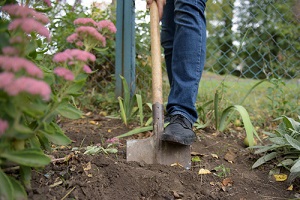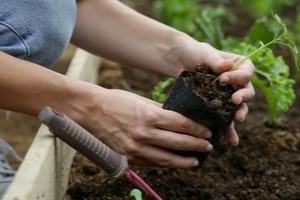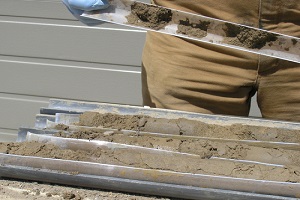 For any gardening endeavor to be successful, it is important to ensure that the soil is not compacted. When soil does not have enough air space within it, water and nutrients will be unable to circulate, which means that the plant’s roots will have nowhere to grow.
For any gardening endeavor to be successful, it is important to ensure that the soil is not compacted. When soil does not have enough air space within it, water and nutrients will be unable to circulate, which means that the plant’s roots will have nowhere to grow.
There are lots of ways that soil can become compacted, but it is possible to fix compacted soil by breaking up and reintroducing some air into it so that it will be more conducive to gardening.
Protecting A Compacted Area
The first method for addressing soil compaction in the garden involves protecting the area that is prone to soil compaction. Here is a look at what can be done to solve this problem.
Determine The Cause Of The Compaction
Remedying soil compaction problems is often a matter of stopping the behavior that led to the compaction in the first place. For example, if the area is subject to foot traffic or heavy machinery, it is important to stop these activities right away to prevent further damage.
Compaction may also be occurring because the soil is overtilled or left bare to the rain. Another common cause of compaction is working wet soil. Discover the reason for the compaction and how to fix soil the compacted soil.
Re-Route Traffic In The Area Of Compaction
Areas of heavy soil compaction should not be traveled on by people, vehicles, machinery or livestock. Create alternative routes and block the area off if necessary using barriers such as fences or signs. This will allow the area to get a rest. It may even be necessary to create paths, stock runs or roads to direct all of the traffic to one specific area in order to limit the spread of compaction.
Reduce Cultivation In The Area
If the compacted area is used for gardening or farming, it is a good idea to move the plants elsewhere for at least one growing cycle and plant a cover crop in the compacted area at the end of the season. Rye grass and winter wheat are two good options.
 The roots of the cover crop will help to break up the soil, and they can be mowed next season and turned into the soil with a tiller for further aeration. Tillage radishes are particularly good options for addressing severe compaction because their large roots work deep into the soil and leave behind space once they have decayed.
The roots of the cover crop will help to break up the soil, and they can be mowed next season and turned into the soil with a tiller for further aeration. Tillage radishes are particularly good options for addressing severe compaction because their large roots work deep into the soil and leave behind space once they have decayed.
Aerating The Soil
Another method for reducing soil compaction is introducing air into the soil. Here is a look at how this can be achieved.
Use A Garden Fork
A metal garden fork is often enough to poke holes in soil in small grassy areas. These aeration holes will allow water and air to get into the soil and enable roots to take hold. Starting on one side of the affected area, push the fork into the ground in the same direction every couple of inches. Then, repeat this process in a different direction for optimal aeration.
Dig Up The Compaction
If the soil compaction is not particularly deep, it may be possible to loosen compaction by digging a few inches of dirt up with a shovel. Using a shovel, divide the affected soil into small rows measuring around a foot in width.
Dig small trenches behind each row, and then use the rows of soil to replace the dirt that was removed from the trenches. If the soil is particularly poor, it may be necessary to dig deeper to give the top layer better aeration.
Use A Rototiller
Consider purchasing or renting a rototiller from a home improvement store. Many rototillers have aeration attachments that can be used to solve soil compaction issues. Running the tiller across the soil and then running over it again several more times can work wonders on fixing compacted soil.
However, it is important to keep in mind that tilling too often can contribute to soil compaction and have the opposite effect because it can create a hardpan of soil underneath the tilled area. Moreover, tilling is not as effective on bigger areas as coring machines because tillers only break up the top layer of the soil.
Remove Soil Cores
For large areas of heavy foot traffic such as fields or lawns, consider renting a plug aerator. When rolled across moist soil, this machine will pull out a core of dirt and move it two or three inches away.
 You can use it throughout a large area, being sure to let the soil plugs that it removes dry out before breaking and scattering them. Areas of severe compaction will need multiple passes with the aerating machine. You may also try handheld aerators for smaller gardens. These can be pushed into the soil manually.
You can use it throughout a large area, being sure to let the soil plugs that it removes dry out before breaking and scattering them. Areas of severe compaction will need multiple passes with the aerating machine. You may also try handheld aerators for smaller gardens. These can be pushed into the soil manually.
Before beginning, mark off areas where there are roots or pipes close to the surface. Although aeration plugs are typically only a few inches deep, it could damage structures that sit too close to the surface.
Replace Compacted Soil
In a small area, you might consider the more intensive solution of replacing the soil altogether. You can dig up the compacted soil with a machine or your hands and put it in a planting mound and then bring in some new topsoil and spread it across the area. Keep in mind that shrubs and trees are going to need as many as three feet of replacement soil. Be sure to purchase soil that possesses the right qualities to nurture plant growth.
Reach Out To The Soil Experts At Dirt Connections
Dirt Connections is Northern Virginia’s top choice for fill dirt. We can deliver fill dirt to any residential or commercial site in the area, and we have the knowledge and resources needed to help you complete projects of all sizes successfully. Whether you need screened or unscreened fill dirt, bio mix soils, unscreened or organic topsoil, or structural filler, we can help. Get in touch today to schedule your dirt delivery.
Summary

Dirt Connections was started with one goal in mind: providing quality residential and commercial construction services to clients on time and on budget. Reach out for more information on how we can support your next project.
For your convenience our estimates are free and by appointment. Call 703-940-9949 for a free estimate today!










































